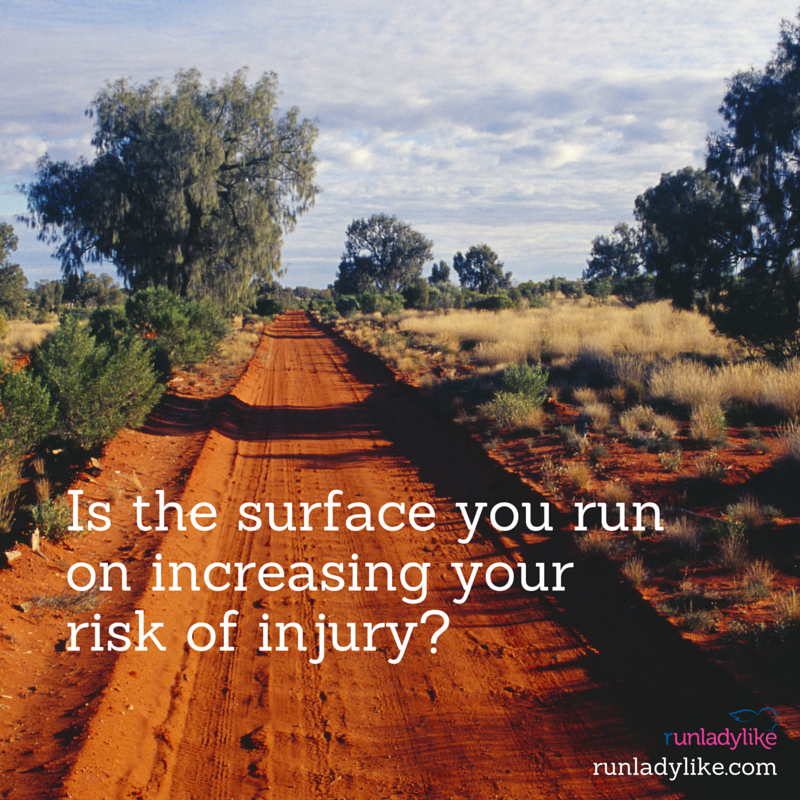Are the Running Surfaces You’re Training on Increasing Your Injury Risk?
When it comes to running injuries, it can often feel that running is a science. There are so many factors that contribute to major running obstacles and setbacks. Training can sometimes feel like a game of Jenga. Everything has to be just right … shoes, balanced muscle strength, training volume, intensity, nutrition … to ensure our body doesn’t start to ache, nag and fall apart on us before we reach the start line of a goal race.

Did you know that the running surfaces you’re training on can impact your injury risk? The ideal running surfaces are firm, smooth and flat, offering some level of shock-absorption. However, we rarely get to run on the perfect running surfaces. City and neighborhood streets and sidewalks weren’t paved with runners in mind. Most of us spend the majority of our miles on asphalt roads or concrete sidewalks. These are rigid running surfaces that require us to wear shock-absorbing shoes to minimize the impact.
Here are some things to keep in mind when choosing the right running surfaces for you to prevent injury.
Choosing the Right Running Surfaces
- Soft, smooth track: A cinder or rubberized track is one of the best running surfaces because it is least likely to aggravate biomechanical injuries. Consider running on a track for shorter runs and speed workouts. The drawbacks are, of course, that running around a 400-meter loop can be extremely monotonous. This is especially true if you’re running long distances. You should change direction frequently on a track to reduce mechanical problems, which isn’t always possible when runners are moving in a counter-clockwise direction.
- Treadmill: Although many runners dread the hamster wheel, most treadmills provide state-of-the-art cushioning and an ideal surface for running. If you can stand the monotony of running in place, this can be a great surface to give your body a break, especially in the severest summer and winter months. Pull out your tunes or watch a TV show/movie to keep your brain stimulated.
- Artificial turf: Unless you’re running 100-meter sprints on the infield of a track or on a football field, it is tough to find continuous artificial turf that provides enough distance to adequately run. Consider this for running strides before or after a run where possible.
- Smooth dirt trail: A smooth dirt trail is a great option for running with reasonable cushioning, especially for longer distances. Find a trail that is mostly free of ruts, holes and large rocks.
- Grass: Running on grass provides good cushioning, but beware of uneven grass where holes or dips could be hiding and pose a potential risk. The best grass to run on is flat, thin and smooth.
- Asphalt street/path or concrete sidewalk: This is where the majority of us tend to run most frequently. Because of the hard, rigid surface, we must rely more heavily on a good pair of running shoes to absorb the shock to our legs and bodies. Beware of sloped or banked surfaces when running on streets and sidewalks. It’s not likely you encounter a run without seeing running surfaces that slant. These banked (or slanted) surfaces will cause one foot to pronate (turn in) and one foot to supinate (turn out) while putting stress on the knees. This can lead to injury over time, so be mindful of avoiding banked edges and slopes where possible.
- Hard sand/beach: Similar to asphalt and concrete, beaches often have slanted or banked surfaces that can aggravate your biomechanics. If and when you do run on the beach, be sure to wear shoes to avoid stepping on a sharp shell or rock that you may not be able to see hiding in the sand. Trail shoes are often helpful when running in the sand.
- Water: Aqua jogging is a great way to maintain your body’s conditioning if and when you are injured. Because you don’t have gravity on your side, it can be harder than road running, but it provides a good alternative to your joints and muscles.
I am a certified marathon coach through the North American Academy of Sport Fitness Professionals (NAASFP). The information contained in this post is sourced from NASSFP teachings and materials.
What running surfaces do you train on most often? Have you ever had an injury arise due to the surface you were running on?



Comments
Really good post! I live by trails now so the majority of my weekday miles are on them. I tend to do all my long runs on concrete or asphalt though!
When I first acquired my ITBS I believe it came from running on banked roads. Now I usually run on trails.